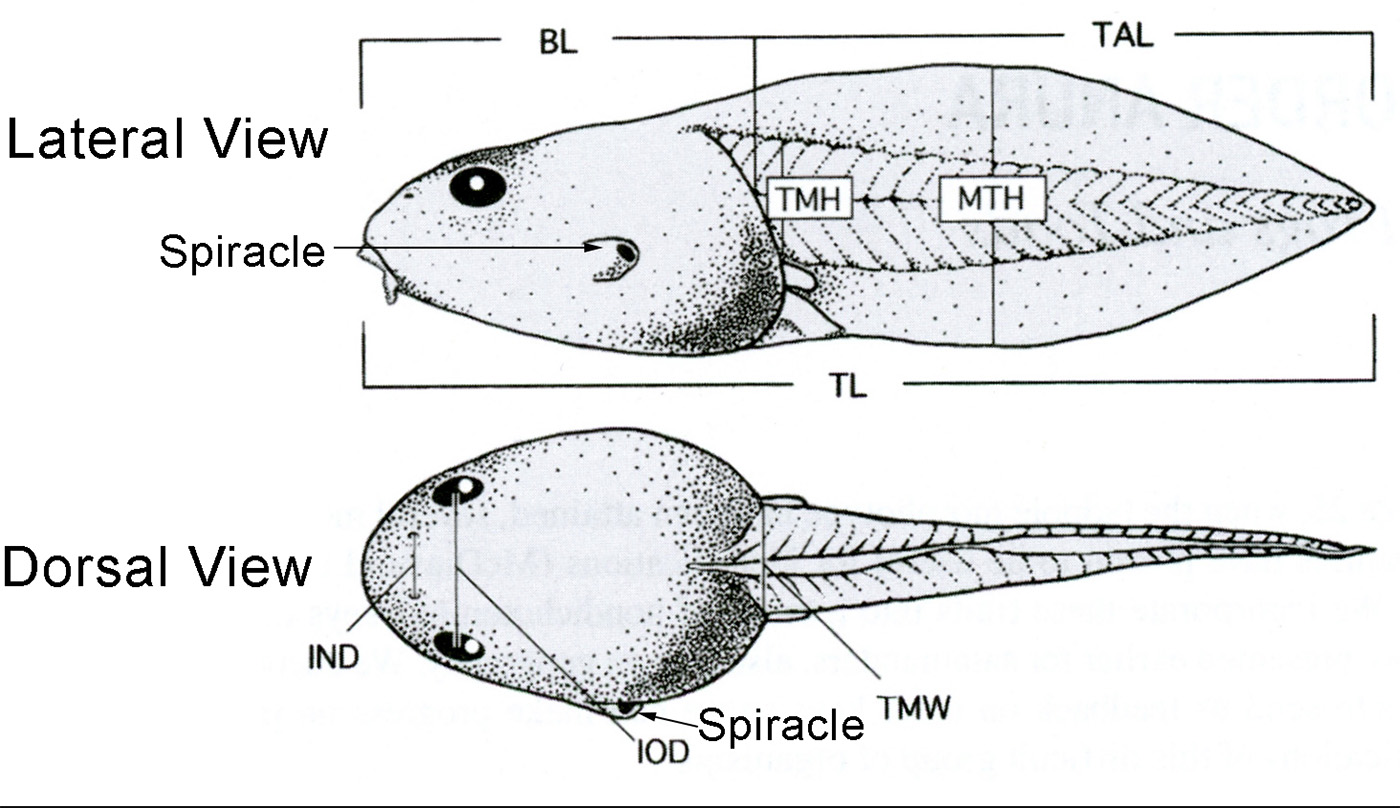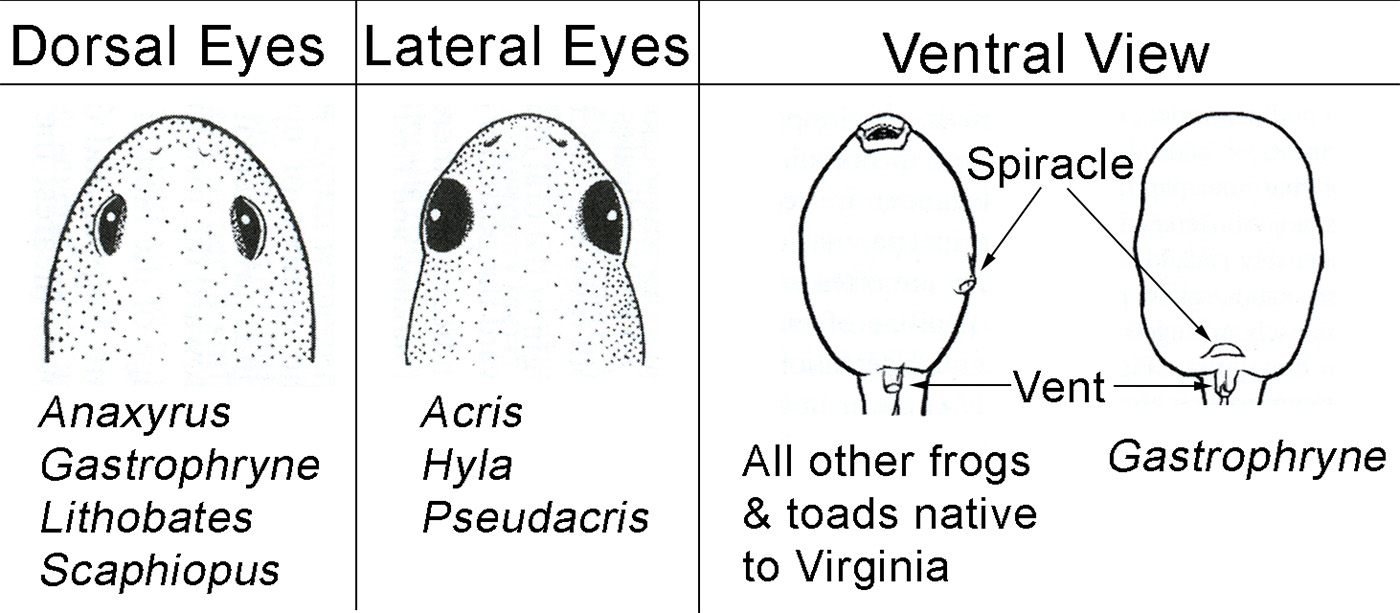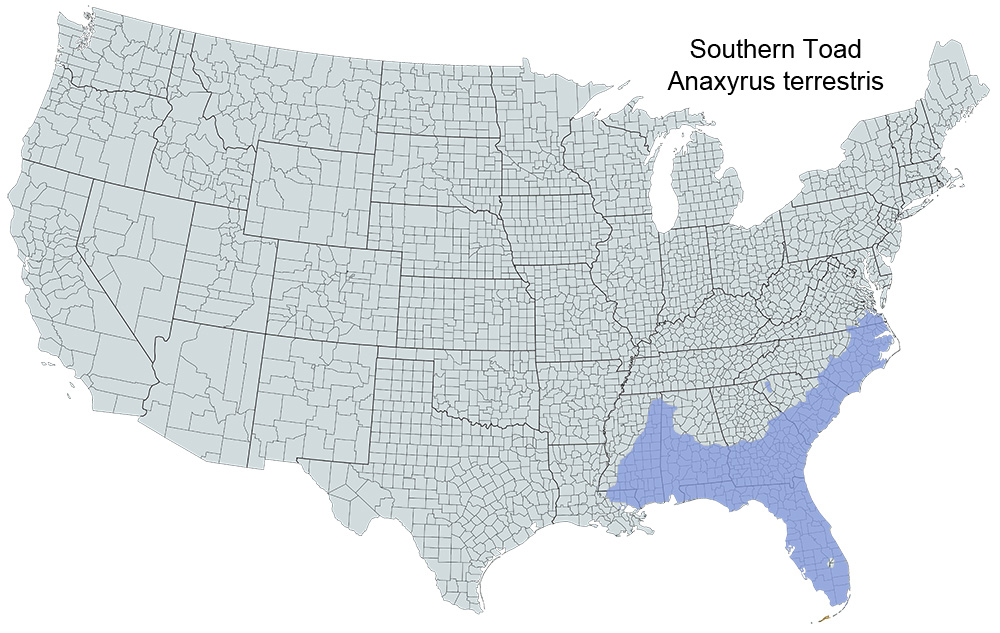Southern Toad
Anaxyrus terrestris
Common Name: |
Southern Toad |
Scientific Name: |
Anaxyrus terrestris (Southern Toad) formerly Bufo terrestris |
Etymology: |
|
Genus: |
Anaxyrus is Greek meaning "A king or chief" |
Species: |
terrestris is Latin and means "of or belonging to the earth" |
Average Length: |
1.6 - 3 in. (4.1 - 7.5 cm) |
Virginia Record Length: |
|
Record length: |
4.5 in. (11.3 cm) |
Physical Description - This species has pronounced knobs and high cranial crests giving its head a sculptured appearance. These knobs are not well developed in young individuals. The crests running from the knobs converge as they approach the snout. It ranges in size from 41 to 98 mm (1 5/8 to 4 inches). Its color is generally brown but ranges from red to black. The ventral section is grayish, and the chest is spotted. This species can be found with or without dark spots. Each spot, if present, will have one or two or often more warts. It may have a light middorsal stripe which is obscured near the posterior section of the back. The female is typically lighter in color and larger than the male.
Historical versus Current Distribution - Southern Toads (Anaxyrus terrestris) primarily occur in the Atlantic Coastal Plain from southeastern Virginia to the Florida Keys, and the Gulf Coastal Plain west through the Florida Parishes of Louisiana (Blem, 1979). Gergus (1993) reported disjunct occurrences of Southern Toads from western Louisiana, however, skepticism exists over the origin of these animals. Although records of Southern Toads outside of the Coastal Plain in Georgia were misidentified (Laerm and Hopkins, 1997), this species does occur in disjunct portions of the Blue Ridge and Piedmont of neighboring South Carolina (Blem, 1979; Conant and Collins, 1998). Southern Toads are also known from the southern portion of the Ridge and Valley region of Alabama (Mount, 1975). No substantial changes in this species’ distribution have been noted.
Historical versus Current Abundance - Southern Toads are common throughout most of their range (Wright and Wright, 1949; Mount, 1975; Blem, 1979), although they have become increasingly uncommon in areas of Florida where non-native Marine Toads (Bufo marinus) have become established (Bartlett and Bartlett, 1999a). Krakauer (1968) suggested that the destruction of preferred habitats of Southern Toads in southern Florida has created better marine Toad habitats and that direct competition between the two species is unlikely responsible for the population changes. Bartlett and Bartlett (1999a) also note that despite massive habitat destruction, Southern Toads remain commonly seen, especially during the breeding season.
Breeding - Reproduction is aquatic.
Breeding migrations - Southern Toads migrate from their sandy upland habitats to the wetland sites in which they breed from February (perhaps earlier) to October (Wright and Wright, 1949; Duellman and Schwartz, 1958; Dundee and Rossman, 1989), although most breeding activity ceases by early summer (personal observations). Breeding aggregations can be enormous (Bartlett and Bartlett, 1999a). Heavy rains at anytime of the year may stimulate chorusing (Krakauer, 1968), although actual breeding may not coincide.
Breeding habitat - Shallow waters, from lake margins to seasonal pools, including cypress ponds and wooded (Carolina) bays (Wright and Wright, 1949), ditches and canals (Dundee and Rossman, 1989; Bartlett and Bartlett, 1999a). Southern Toads breed in both temporary and permanent aquatic habitats (Gibbons and Semlitsch, 1991). Wright and Wright (1949) commented: "On one occasion their eggs were so plentiful in impermanent pools that we wrote: What a frightful waste of frog life in transient pools." Mount (1975) notes that, as opposed to Fowler's Toads, he has never seen Southern Toads breeding in streams or rivers.
Egg deposition sites - Shallow waters from the littoral regions of lakes to seasonal wetlands, usually amongst aquatic vegetation.
Altig & McDiarmid 2015 - Classification and Description:
- Eastern Linear
- Arrangement 3 - Eggs oviposited as strings.
- Sub-arrangement D - Jelly tube bilayered and obvious, string long. Eggs deposited in ephemeral sites and lake margins; Ovum Diameter 1.0-1.5 mm; tube diameter 2.2-4.6 mm; partitions absent between uniserial, widely spaced ova.
- Arrangement 3 - Eggs oviposited as strings.
Clutch size - Southern Toads lay 2,500–4,000 eggs, 1–1.4 mm in diameter, in long coils that hatch in 2–4 d, depending on water temperature (Wright and Wright, 1949; Ashton and Ashton, 1988; Bartlett and Bartlett, 1999a).
Length of larval stage - Southern Toad tadpoles hatch and develop in 30–55 d; tadpoles transform at 6.5–11 mm (Wright and Wright, 1949; Ashton and Ashton, 1988).
Tadpoles:

| Lateral View | Dorsal View |
|---|---|
| BL = Body Length | IND = Internarial Distance |
| MTH = Maximum Tail Height | IOD = Interorbital Distance |
| TAL = Tail Length | TMW = Tail Muscle Width |
| TL = Total Length | |
| TMH = Tail Muscle Height |

Larvae Food - Algae scraped from aquatic vegetation (Ashton and Ashton, 1988). Tadpoles have been observed opportunistically feeding on the eggs of previously killed gravid female Southern Toads (Babbitt, 1995).
Cover - As with most Anaxyrus tadpoles, those of Southern Toads are unpalatable or toxic to many potential predators (Michl and Kaiser, 1963; Lefcort, 1998), therefore cover may not be critically important. However, Babbitt and Jordan (1996) found that Southern Toads had increased survival in dense plant refugia when pursued by odonates. Southern Toad tadpoles frequently school together (Lefcort, 1998) and are often quite conspicuous in open areas of water despite having nearby cover of emergent and submerged plants available (personal observations). Further, Southern Toad tadpoles select areas of higher temperature (i.e., exposed areas) within their aquatic habitats that favor a higher metabolic rate and faster development (Noland and Ultsch, 1981).
Larval polymorphisms - Unknown for this species.
Features of metamorphosis - The age at metamorphosis for toadlets studied in South Carolina was 54–63 d at a mean SVL of 7.46 mm (Beck and Congdon, 1999).
Post-metamorphic migrations - Following transformation and prior to emigration, juvenile southern Toads forage for several weeks around the edge of the pond from which they emerged (Beck and Congdon, 1999).
Juvenile Habitat - Unknown, though likely similar to adults.
Adult Habitat - Southern Toads can be common in a variety of terrestrial habitats including agricultural fields, pine woodlands, hammocks, and maritime forests (Wright and Wright, 1949; Kraukauer, 1968; Wilson, 1995). Sandy soils are preferred (Blem, 1979; Martof et al., 1980) to accommodate their burrowing needs. Adults may also take refuge under logs or other debris during the day (Ashton and Ashton, 1998). Southern Toads tolerate humans well, and Ashton and Ashton (1988) note that they are a common yard and garden toad, frequently found under lights at night feeding on attracted insects (see also Neill, 1950a; Behler and King, 1998). It is not known whether the habitat characteristics of males differ substantially from that of females.
Home Range Size - "May encompass an area a mile [1.6 km] wide" (Bogert, 1947).
Territories - Unknown.
Aestivation/Avoiding Dessication - Southern Toads remain active throughout the summer.
Torpor (Hibernation) - During the coldest months, Southern Toads are much less conspicuous and may remain inactive in their burrows or under cover items. Neill (1950a) reported that Southern Toads dig into the ground to a depth of a foot (30 cm) or more during this time. However, Einem and Ober (1956) reported feeding activity of Southern Toads throughout the winter in central Florida.
Interspecific Associations/Exclusions - Southern Toads will hybridize with Fowler's Toads (A. fowleri ; Neill, 1949a; L.E. Brown, 1969; Blem, 1979) and American Toads (A. americanus; Mount, 1975; Blem, 1979). In Georgia and perhaps elsewhere, Southern Toads and American Toads appear strongly allopatric along the Fall Line (Neill, 1949a; personal observations). Many other anurans share breeding sites with Southern Toads including, but not limited to, Oak Toads (A. quercicus; Bogert, 1947), Southern Cricket Frogs (Acris gryllus), Barking Treefrogs (Dryophytes gratiosus), Pinewoods Treefrogs (Dryophytes femoralis), Squirrel Treefrogs (Dryophytes squirellus), and Southern Leopard Frogs (Lithobates sphenocephala; personal observations).
Age/Size at Reproductive Maturity - Males 42–82 mm SVL; females 44–92 mm SVL (Wright and Wright, 1949). Dundee and Rossmann (1989) cite a maximum of 113 mm, although note that the largest animal known from Louisiana is 64 mm. Adults found on many of the coastal islands of South Carolina, Georgia, Mississippi, and Florida can reach exceptionally large sizes (Smith and List, 1955; Sanders, 1961; Mount, 1975; personal observations); however, island populations of dwarfed southern Toads have also been reported (Duellman and Schwartz, 1958).
Longevity - Perhaps at least 10 yr (Ashton and Ashton, 1988).
Feeding Behavior - Typically will eat small invertebrates including beetles, earwigs, ants, cockroaches, mole crickets, and snails (Duellman and Schwartz, 1958), but are known to eat anything they can swallow (Ashton and Ashton, 1988). Beetles were especially abundant in the diet of southern Toads from Georgia and southern Florida (Neill and Allen, 1956; Duellman and Schwartz, 1958). Huheey (1980) found that Southern Toads in captivity continued to eat honeybees despite being stung during previous consumptions. Wilson (1995) suggested that this species is an insectivore that captures its prey with its sticky tongue. Southern Toads accumulate large fat reserves to sustain them through a continuous period without food, from late fall until breeding is completed (Smith, 1976).
Predators - Hog-nosed snakes (both Heterodon platyrhinos and H. simus) feed heavily on adult Southern Toads (Bogert, 1947; Gibbons and Semlitsch, 1991; Palmer and Braswell, 1995). Adult Southern Toads have also been found in the diets of water snakes (both Nerodia erythrogaster and N. fasciata; Neill and Allen, 1956; Palmer and Braswell, 1995) and Eastern Indigo Snakes (Drymarchon couperi; Bogert, 1947). Two-toed Amphiumas (Amphiuma means), Lesser Sirens (Siren intermedia), and odonates are known predators of Southern Toad tadpoles (Babbit and Jordan, 1996; Lefcort, 1998). Additionally, giant water bugs (Hemiptera, Belastomatidae) will eat breeding adults (McCoy, 2003).
Anti-Predator Mechanisms - As with other Anaxyrus spp., Southern Toads will inflate their lungs, thereby puffing up their body in an effort to appear much larger to a potential predator (Duellman and Trueb, 1986; personal observations). Bufotoxin, a cardiotoxic steroid (Duellman and Trueb, 1986) released from the parotoid glands of Anaxyrus spp. is toxic and/or unpalatable to many would-be predators. In fact, when triggered to inflate their bodies, Anaxyrus spp. flex their head downward to present the parotoid glands to potential predators. Truitt (1964) observed defensive behavior of a Southern Toad towards an Eastern Hog-nosed Snake. These behaviors included crab-like movements, charges, and sand kicking directed at the snake, but were ultimately unsuccessful in deterring the snake and the toad was consumed. Jensen (1996) found that eggs were fatally toxic, by contact, to Southern Cricket Frogs (Acris gryllus) that fell into pitfall buckets where captured female Southern Toads previously oviposited in the few inches of water present in the bottom of the buckets. Anaxyrus eggs are also unpalatable or toxic to many animals that eat them (Licht, 1968), and the affected water surrounding the eggs may provide a chemical barrier that repels potential amphibian egg predators such as newts (Notophthalmus sp.; Jensen, 1996).
Diseases - Unknown.
Parasites - The nematode Cosmocercoides dukae has been found in Southern Toads from south Florida (Walton, 1940).
Conservation - Southern Toads are common throughout most of their range, although they have become increasingly uncommon in areas of Florida where non-native marine Toads have become established. Southern Toads remain commonly seen, especially during the breeding season, even in areas with extensive habitat destruction. They are not protected by either state or federal regulations.
References for Life History
- Altig, Ronald & McDiarmid, Roy W. 2015. Handbook of Larval Amphibians of the United States and Canada. Cornell University Press, Ithaca, NY. 341 pages.
- AmphibiaWeb. 2020. University of California, Berkeley, CA, USA.
- Conant, Roger and, Collins, John T., 2016, Peterson Field Guide: Reptiles and Amphibians, Eastern and Central North America, 494 pgs., Houghton Mifflin Company., New York
- Duellman, William E. and, Trueb, Linda, 1986, Biology of Amphibians, 671 pgs., The Johns Hopkins University Press, Baltimore
- Martof, B.S., Palmer, W.M., Bailey, J.R., Harrison, III J.R., 1980, Amphibians and Reptiles of the Carolinas and Virginia, 264 pgs., UNC Press, Chapel Hill, NC
- Wilson, L.A., 1995, Land manager's guide to the amphibians and reptiles of the South, 360 pp. pgs., The Nature Conservancy, Southeastern Region, Chapel Hill, NC
Photos:
*Click on a thumbnail for a larger version.
Verified County/City Occurrence
Brunswick
Charles City
Henrico
Isle of Wight
James City
King William
Prince George
Southampton
Surry
Sussex
CITIES
Chesapeake
Norfolk
Suffolk
Virginia Beach
Verified in 10 counties and 4 cities.
U.S. Range







